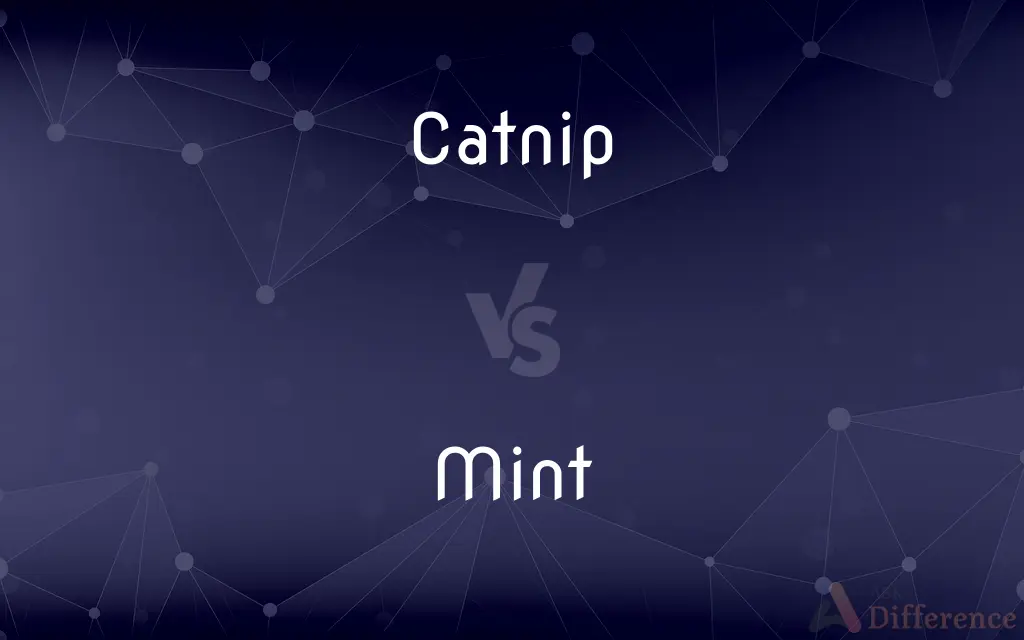Catnip vs. Mint — What's the Difference?
By Maham Liaqat & Fiza Rafique — Updated on April 2, 2024
Catnip is a herb beloved by cats for its stimulating effects, while mint is widely used in culinary and medicinal applications for humans.

Difference Between Catnip and Mint
Table of Contents
ADVERTISEMENT
Key Differences
Catnip, scientifically known as Nepeta cataria, is a member of the mint family, Lamiaceae, known for its unique effect on cats, causing a temporary state of euphoria or hyperactivity. This reaction is due to nepetalactone, a volatile oil found in catnip that interacts with the sensory neurons of cats. Whereas mint refers to a group of plants within the same family, characterized by their aromatic leaves that are used in cooking, teas, and for medicinal purposes. The mint genus, Mentha, encompasses a variety of species, including peppermint and spearmint, known for their refreshing flavor and aroma.
The main distinction between catnip and mint lies in their use and the reactions they provoke. Catnip is primarily recognized for its effect on felines, although it can also be used in herbal teas and as a mosquito repellent for humans. On the other hand, mint is widely utilized in culinary applications, from flavoring dishes and beverages to providing health benefits such as aiding digestion and relieving symptoms of the common cold.
In terms of cultivation, both catnip and mint are relatively easy to grow and can be invasive if not managed properly. They thrive in similar conditions, preferring full sun to partial shade and well-drained soil. However, catnip plants are specifically sought after by cat owners and are often planted in gardens to attract and entertain their pets, while mint is cultivated for its culinary and medicinal properties.
Despite their similarities, including their appearance and growth habits, catnip and mint serve different purposes and hold different attractions for cats and humans, respectively. Catnip's allure for cats is unmatched by mint, which lacks the nepetalactone compound responsible for the reaction in felines.
While both plants are valuable in their respective contexts, they are distinguished by their primary uses and the unique chemical compounds they contain. This distinction is important for gardeners, pet owners, and culinary enthusiasts alike, who may choose to grow one or both plants depending on their needs and interests.
ADVERTISEMENT
Comparison Chart
Scientific Name
Nepeta cataria
Mentha
Primary Use
Stimulating effect on cats
Culinary and medicinal use for humans
Key Compound
Nepetalactone
Menthol (in some species)
Effect on Cats
Euphoria and hyperactivity
No significant effect
Culinary Use
Limited to herbal teas
Extensive, in dishes, beverages, and teas
Compare with Definitions
Catnip
Thrives in full sun to partial shade and well-drained soil.
My catnip plant has grown rapidly in the sunny corner of the yard.
Mint
Can be invasive, requiring careful management.
Mint has taken over my herb garden, so I'm planning to replant it in pots.
Catnip
A herb from the mint family that induces euphoria in cats.
The cat rolled in the catnip with visible delight.
Mint
A versatile herb used in cooking, teas, and for medicinal purposes.
I added fresh mint to the lemonade for a refreshing taste.
Catnip
Known for its invasive growth habits if not managed.
I need to regularly trim the catnip to prevent it from taking over my garden.
Mint
Known for its aromatic leaves and refreshing flavor.
The scent of mint in the garden is incredibly invigorating.
Catnip
Used in herbal teas and as a natural mosquito repellent for humans.
I planted catnip in my garden for its mosquito-repellent properties.
Mint
Encompasses a variety of species, including peppermint and spearmint.
Peppermint is my go-to herb for making soothing teas.
Catnip
Characterized by its heart-shaped leaves and white flowers with purple spots.
Catnip blooms throughout the summer, attracting both cats and bees.
Mint
Also thrives in full sun to partial shade and well-drained soil.
Mint plants are easy to grow and have spread throughout my garden.
Catnip
Any of various other mostly aromatic plants of the genus Nepeta, cultivated for their ornamental foliage and clusters of blue, lavender, or white flowers.
Mint
A place where the coins of a country are manufactured by authority of the government.
Catnip
Nepeta cataria, commonly known as catnip, catswort, catwort, and catmint, is a species of the genus Nepeta in the family Lamiaceae, native to southern and eastern Europe, the Middle East, Central Asia, and parts of China. It is widely naturalized in northern Europe, New Zealand, and North America.
Mint
A place or source of manufacture or invention.
Catnip
A hairy aromatic perennial herb (Nepeta cataria) in the mint family, native to Eurasia and containing an aromatic oil to which cats are strongly attracted.
Mint
An abundant amount, especially of money.
Catnip
Any of the about 250 species of flowering plant of the genus Nepeta, family Lamiaceae, certain of which are said to have medicinal qualities.
Mint
A member of the mint family.
Catnip
Nepeta cataria and Nepeta grandiflora (and perhaps other species), which are well-known for causing an apparently harmless pheromone-based intoxication among certain cats.
Silver vine
Some cats go bonkers over catnip; others ignore it.
Mint
Any of various rhizomatous plants of the genus Mentha of the mint family, characteristically having nearly regular white or purple flowers. Some species are cultivated for their aromatic oil and foliage.
Catnip
(figurative) Something that causes excitement or interest.
Mint
The leaves of some of these plants, used as a seasoning.
Catnip
A well-know plant of the genus Nepeta (Nepeta Cataria), somewhat like mint, having a string scent, and sometimes used in medicine. It is so called because cats have a peculiar fondness for it.
Mint
Any of various similar or related plants, such as the stone mint.
Catnip
Hairy aromatic perennial herb having whorls of small white purple-spotted flowers in a terminal spike; used in the past as a domestic remedy; strongly attractive to cats
Mint
A candy flavored with natural or artificial mint flavoring.
Mint
To produce (money) by stamping metal; coin.
Mint
To invent or fabricate
A phrase that was minted for one occasion.
Mint
Undamaged as if freshly minted
The painting was in mint condition.
Mint
A building or institution where money (originally, only coins) is produced under government licence.
Mint
(informal) A vast sum of money; (by extension) a large amount of something.
That house is worth a mint.
It must have cost a mint to produce!
To make a mint
Mint
(figuratively) Any place regarded as a source of unlimited supply; the supply itself.
Mint
Any plant in the genus Mentha in the family Lamiaceae, typically aromatic with square stems.
Mint
The flavouring of the plant, either a sweet, a jelly or sauce.
Mint
Any plant in the mint family, Lamiaceae.
Mint
A green colour, like that of mint.
Mint
A mint-flavored candy, often eaten to sweeten the smell of the breath.
Mint
Intent, purpose; an attempt, try; effort, endeavor.
Mint
(transitive) To reproduce (coins), usually en masse, under licence.
Mint
To invent; to forge; to fabricate; to fashion.
Mint
To create a crypto token.
Mint
To try, attempt; take aim.
Mint
To try, attempt, endeavor; to take aim at; to try to hit; to purpose.
Mint
To hint; suggest; insinuate.
Mint
(with condition) Like new.
In mint condition
Mint
In near-perfect condition; uncirculated.
Mint
(philately) Unused with original gum; as issued originally.
Mint
Very good.
Mint
Attractive; beautiful; handsome.
Mint
Of a green colour, like that of the mint plant.
Mint
The name of several aromatic labiate plants, mostly of the genus Mentha, yielding odoriferous essential oils by distillation. See Mentha.
Mint
A place where money is coined by public authority.
Mint
Any place regarded as a source of unlimited supply; the supply itself.
A mint of phrases in his brain.
Mint
A large quantity of money; as, to make a mint in stock trading.
Mint
To make by stamping, as money; to coin; to make and stamp into money.
Mint
To invent; to forge; to fabricate; to fashion.
Titles . . . of such natures as may be easily minted.
Mint
Like new; in brand-new condition; unworn, as a coin recently made at a mint{1}; as, he had a '53 Cadillac in mint condition.
Mint
Uncirculated; in the same condition as when it was freshly coined at the mint{1}.
Mint
(often followed by `of') a large number or amount or extent;
A batch of letters
A deal of trouble
A lot of money
He made a mint on the stock market
It must have cost plenty
Mint
Any north temperate plant of the genus Mentha with aromatic leaves and small mauve flowers
Mint
The leaves of a mint plant used fresh or candied
Mint
A candy that is flavored with a mint oil
Mint
A plant where money is coined by authority of the government
Mint
Form by stamping, punching, or printing;
Strike coins
Strike a medal
Mint
As if new;
In mint condition
Common Curiosities
Why doesn't mint affect cats like catnip does?
Mint lacks nepetalactone, the compound in catnip that causes a euphoric reaction in cats.
What makes catnip different from mint?
Catnip has a unique compound, nepetalactone, that affects cats, whereas mint is valued for its culinary and medicinal uses for humans.
How can I prevent mint and catnip from being invasive in my garden?
Planting mint and catnip in containers or raised beds can help control their spread.
Can humans use catnip for culinary purposes?
Yes, catnip can be used in herbal teas but is less commonly used in cooking compared to mint.
How do I harvest mint without killing the plant?
Mint can be harvested by cutting the stems just above a pair of leaves, encouraging the plant to branch out and become bushier.
Can I grow catnip and mint together in the same garden?
While you can grow catnip and mint together, they both can be invasive, so careful management is needed to prevent them from overtaking the garden.
How do I make tea from fresh catnip and mint?
To make tea, steep fresh or dried leaves in boiling water for several minutes, then strain and enjoy.
Is mint safe for cats?
Mint is generally safe for cats in small amounts, but it doesn't have the same stimulating effect as catnip and some mint species may be irritating to them.
Can mint help with digestion?
Yes, mint has been used traditionally to aid digestion and soothe stomach issues.
Is there a best time of year to plant catnip and mint?
Early spring, after the last frost, is an ideal time to plant both catnip and mint.
Can catnip be used for any purposes other than entertaining cats?
Beyond entertaining cats, catnip is used in herbal teas and as a natural mosquito repellent for humans.
Are all cats affected by catnip?
Not all cats are affected by catnip; sensitivity to nepetalactone is hereditary, and about 50-70% of cats are affected.
Do catnip and mint require a lot of water?
Both catnip and mint prefer well-drained soil and should be watered regularly, but they don't like to be waterlogged.
How long does it take for catnip and mint to mature and be ready for harvest?
Catnip and mint typically take a few months to mature after planting, and can be harvested as soon as they have enough leaves to sustain growth.
Can I use mint in homemade skincare products?
Yes, mint is often used in homemade skincare for its refreshing scent and cooling properties.
Share Your Discovery

Previous Comparison
Caudal vs. Fluke
Next Comparison
Attribute vs. CharacteristicAuthor Spotlight
Written by
Maham LiaqatCo-written by
Fiza RafiqueFiza Rafique is a skilled content writer at AskDifference.com, where she meticulously refines and enhances written pieces. Drawing from her vast editorial expertise, Fiza ensures clarity, accuracy, and precision in every article. Passionate about language, she continually seeks to elevate the quality of content for readers worldwide.














































